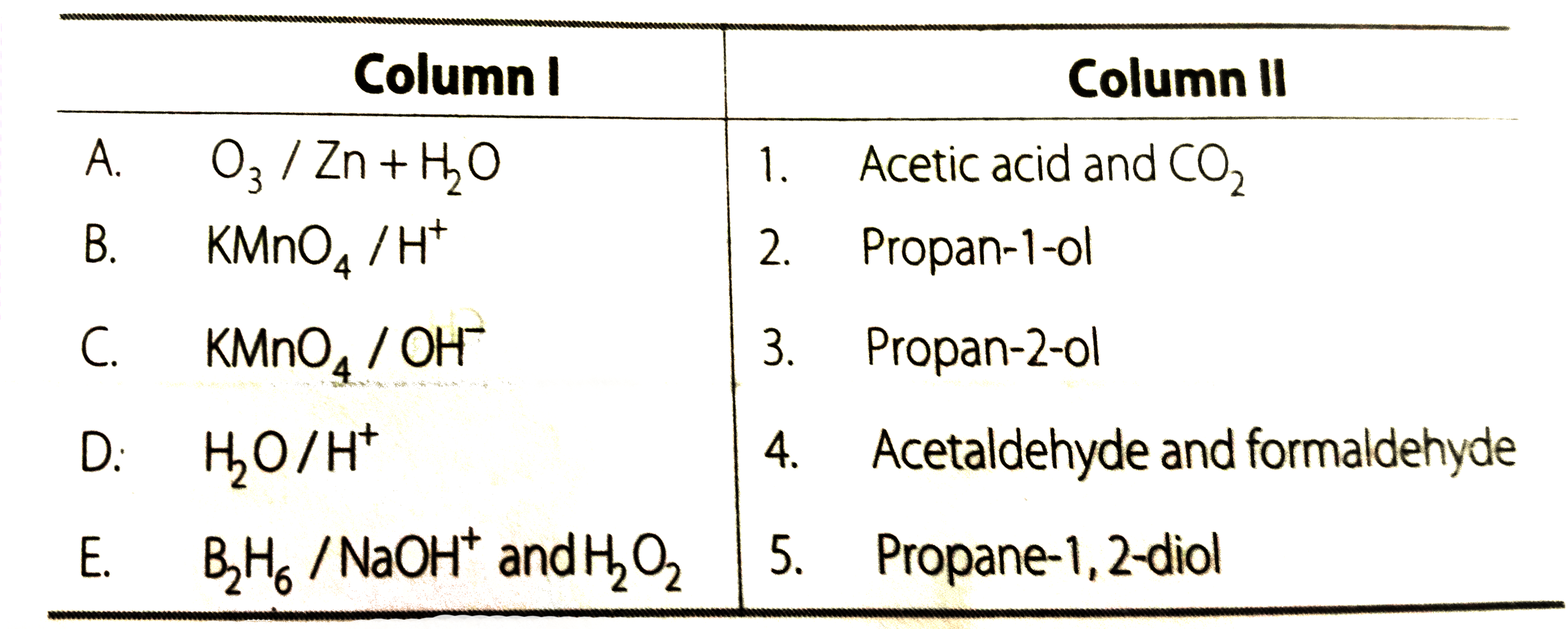Match the following enzymes given in Column I with the reactions they catalyse given in Column II.
ColumnI(Enzymes)ColumnII(Reactions)A.Invertase1.Decomposition of urea intoNH3andCO2B.Maltase2.Conversion of glucose into enthyl alcoholC.Pepsin3.Hydrolysis of maltose into glucoseD.Urease4.Hydrolysis of cane sugarE.Zymase5.Hydrolysis of proteins into peptides
The correct Answer is:A. →(4) B. →(3) C. →(5) D. →(1) E. →(2)
To solve the problem of matching the enzymes in Column I with their corresponding reactions in Column II, we will analyze each enzyme and the reaction it catalyzes step by step.
1. Invertase (A):
- Invertase is an enzyme that catalyzes the hydrolysis of sucrose (cane sugar) into glucose and fructose.
- Match: A → 4 (Hydrolysis of cane sugar)
2. Maltase (B):
- Maltase is responsible for breaking down maltose, a disaccharide, into two molecules of glucose.
- Match: B → 3 (Hydrolysis of maltose into glucose)
3. Pepsin (C):
- Pepsin is a digestive enzyme that catalyzes the hydrolysis of proteins into smaller peptides.
- Match: C → 5 (Hydrolysis of proteins into peptides)
4. Urease (D):
- Urease catalyzes the decomposition of urea into ammonia (NH₃) and carbon dioxide (CO₂).
- Match: D → 1 (Decomposition of urea into NH₃ and CO₂)
5. Zymase (E):
- Zymase is a complex of enzymes that catalyzes the fermentation process, converting glucose into ethyl alcohol (ethanol).
- Match: E → 2 (Conversion of glucose into ethyl alcohol)
Final Matching:
- A → 4
- B → 3
- C → 5
- D → 1
- E → 2
- Invertase is an enzyme that catalyzes the hydrolysis of sucrose (cane sugar) into glucose and fructose.
- Match: A → 4 (Hydrolysis of cane sugar)
- Maltase is responsible for breaking down maltose, a disaccharide, into two molecules of glucose.
- Match: B → 3 (Hydrolysis of maltose into glucose)
- Pepsin is a digestive enzyme that catalyzes the hydrolysis of proteins into smaller peptides.
- Match: C → 5 (Hydrolysis of proteins into peptides)
- Urease catalyzes the decomposition of urea into ammonia (NH₃) and carbon dioxide (CO₂).
- Match: D → 1 (Decomposition of urea into NH₃ and CO₂)
- Zymase is a complex of enzymes that catalyzes the fermentation process, converting glucose into ethyl alcohol (ethanol).
- Match: E → 2 (Conversion of glucose into ethyl alcohol)
- A → 4
- B → 3
- C → 5
- D → 1
- E → 2
Topper's Solved these Questions
- BOOK - NCERT EXEMPLAR ENGLISHCHAPTER - BIOMOLECULES EXERCISE - Assertion and Reason7videos
BIOMOLECULES
- BOOK - NCERT EXEMPLAR ENGLISHCHAPTER - BIOMOLECULES EXERCISE - Long Answer Type Questions5videos
BIOMOLECULES
- BOOK - NCERT EXEMPLAR ENGLISHCHAPTER - BIOMOLECULES EXERCISE - Short Answer Type Questions29videos
BIOMOLECULES
- BOOK - NCERT EXEMPLAR ENGLISHCHAPTER - AMINESEXERCISE - LONG ANSWER3videos
AMINES
- BOOK - NCERT EXEMPLAR ENGLISHCHAPTER - CHEMICAL KINETICSEXERCISE - LONG ANSWER TYPE QUESTIONS5videos
CHEMICAL KINETICS
Similar Questions
Match the elements given in column (I) with the most appropriate expected values given in column (II)
Column IColumn IIElementElectronegative valuesA.F(p)3.5B.O(q)3.0C.N(r)4.0D.C(s)2.5View SolutionMatch the types of colloidal systems given in Column I with the name given in Column II.
Column IColumn IIA.Solid in liquid1.FoamB.Liquid in solid 2.SolC.Liquid in liquid 3.GelD.Gas in liquid4.EmulsionView SolutionMatch the items given in Column 1 with examples give in Column II.
Column IColumn II(a)Hydrogen bond(i)C(b)Resonance(ii)LiF(c)Ionic solid(iii)H2(d)Covalent solid(iv)HF(v)O3View SolutionMatch the enzymes given in column I with the substrates they act upon in column II and the product obtained from the reaction given in column III and select the correct. Option from the codes given below .
 View Solution
View SolutionMatch the vitamins given in Column I with the deficiency disease they cause given in Column II.
ColumnI(Vitamins)ColumnII(Diseases)A.VitaminA1.Pernicious anaemiaB.VitaminB12.Increased blood clotting timeC.VitaminB123.XerophthalmiaD.VitaminC4.RicketsE.VitaminD5.Muscular weaknessF.VitaminE6.Night blindnessG.VitaminK7.Beri-beri8.Bleeding gums9.OsteomalaciaView SolutionMatch the reagent from Column I which on reaction with CH3−CH=CH2 gives some product given in Column II as per the codes given below
 View Solution
View SolutionMatch the shape of molecules in Column 1 with the type of hybridisation in Column II.
Column IColumn II(a)Tetrahedral(i)sp2(b)Trigonal(ii)sp(c)Linear(iii)sp3(d)Trigonal bipyramidal(iv)sp3dView SolutionMatch the items of Column I and Column II.
Column IColumn IIA. Butter 1. Dispersion of liquid in liquid B. Pumice stone 2. Dispersion of solid in liquidC. Milk3. Dispersion of gas in solidD. Paints4. Dispersion of liquid in solidView SolutionMatch the following and choose the correct combination from the option given
Column IColumn IIa.Sulphuri.Chlorophyllb.zincii.Nitrogenasec.Magnesiumiii.Methionined.Molybdenumiv.AuxinView SolutionMatch column I with column II and select the correct option from the codes given below ltBrgt Column IColumn IIA. Uremia(i). Ketone bodies in urineB. Ketonuria(ii). Artificial kidneyC. Glycosuria(iii). Glucose in urineD. Blood dialyser(iv). Accumulation of urea in blood
View Solution

